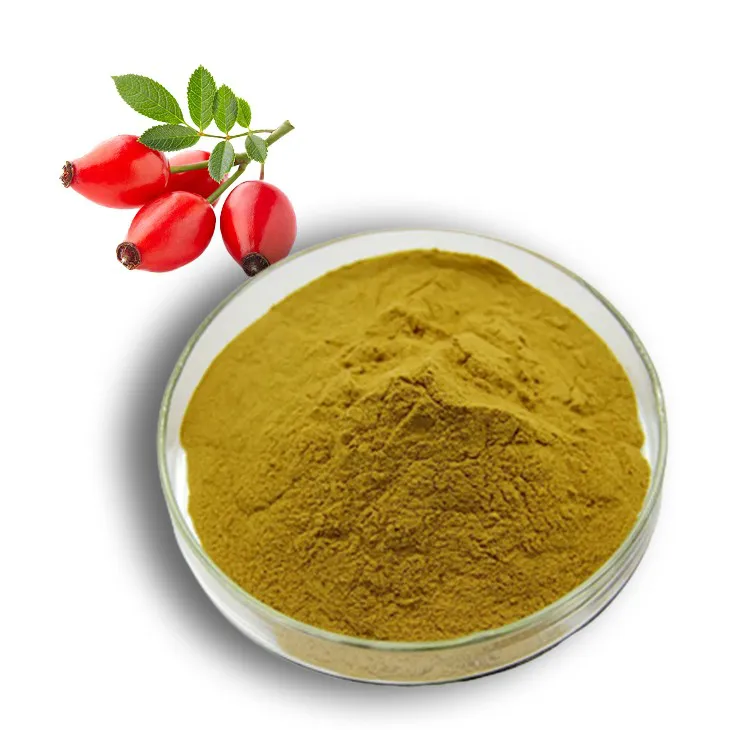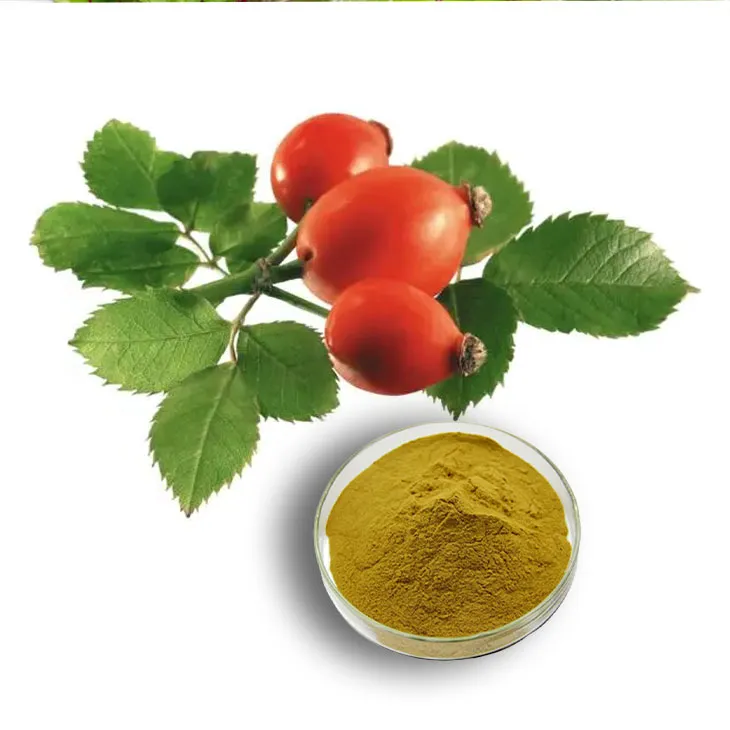- 0086-571-85302990
- sales@greenskybio.com
Extraction process of rose hip extract.
2024-11-30

1. Introduction
Rose Hip Extract has gained significant attention in recent years due to its rich content of bioactive compounds. These compounds possess various beneficial properties, making the extract valuable in the cosmetics, pharmaceuticals, and food industries. The extraction process of Rose Hip Extract is a crucial step in obtaining a high - quality product with desirable properties. Harvesting, pretreatment, and different extraction methods all play important roles in this process.

2. Harvesting of Rose Hips
The quality of Rose Hip Extract starts with the proper harvesting of rose hips. Harvest time is a critical factor. Rose hips should be harvested at the right moment to ensure the maximum content of bioactive substances.
- Harvesting too early may result in under - developed rose hips with a lower concentration of the desired compounds.
- On the other hand, if harvested too late, there is a risk of the rose hips being damaged by environmental factors or starting to decay, which can also reduce the quality of the extract.

3. Pretreatment of Rose Hips
After harvesting, the rose hips need to be pretreated. This pretreatment involves several important steps:
- Sorting: The rose hips are sorted to separate the good - quality ones from the damaged or diseased ones. Damaged rose hips may contain contaminants or have reduced levels of bioactive substances, so removing them is essential for obtaining a high - quality extract.
- Cleaning: Once sorted, the rose hips are cleaned to remove any dirt, debris, or foreign matter. This can be done using gentle washing methods to avoid damaging the rose hips.

4. Extraction Methods
4.1 Soxhlet Extraction
One of the traditional and widely used methods for extracting rose hip extract is Soxhlet extraction.
- In this method, the pretreated rose hips are placed in a Soxhlet apparatus. The Soxhlet apparatus consists of a flask, a condenser, and a siphon - like device.
- A suitable solvent is selected. The choice of solvent depends on the nature of the bioactive compounds to be extracted. Commonly used solvents include ethanol, methanol, or a mixture of solvents.
- The solvent is continuously circulated through the sample in the Soxhlet apparatus. The solvent in the flask is heated, vaporizes, rises to the condenser, where it condenses back into a liquid, and then drips onto the rose hips. As the solvent level in the extraction chamber rises, it is siphoned back into the flask. This continuous process of solvent circulation ensures that a large amount of the active ingredients are extracted from the rose hips.
- However, Soxhlet extraction has some limitations. It may require a relatively long extraction time, which can be a drawback in terms of efficiency. Additionally, the use of large amounts of solvent may also pose environmental and cost - related challenges.
4.2 Microwave - Assisted Extraction
Microwave - assisted extraction is a more modern and efficient method for obtaining rose hip extract.
- In this method, the rose hips are placed in a microwave - compatible vessel along with the solvent. The microwaves are then applied to the system.
- When microwaves are applied, the internal temperature of the rose hips rises rapidly. This is due to the interaction of the microwaves with the polar molecules in the rose hips and the solvent. The rapid increase in temperature enhances the mass transfer of the components from the rose hips to the solvent.
- Microwave - assisted extraction has several advantages over Soxhlet extraction. It is generally faster, which can significantly reduce the extraction time. It also has the potential to use less solvent, which is more environmentally friendly and cost - effective.
- However, it also requires careful control of the microwave parameters such as power and exposure time. Incorrect settings can lead to over - extraction or degradation of the bioactive compounds.
5. Refinement and Purification of the Extract
Once the extraction is complete, the resulting extract obtained through either Soxhlet extraction or microwave - assisted extraction can be further refined and purified for different applications.
- Filtration: The extract may contain solid particles such as plant debris or undissolved components. Filtration is a common first step in purification. It can be done using various types of filters, such as filter paper or membrane filters, depending on the size of the particles to be removed.
- Evaporation: To concentrate the extract, evaporation of the solvent may be necessary. This can be achieved using techniques such as rotary evaporation, where the solvent is removed under reduced pressure at a controlled temperature. Care must be taken to avoid over - heating the extract, which could damage the bioactive compounds.
- Chromatographic Purification: For more in - depth purification, chromatographic techniques can be employed. For example, column chromatography can be used to separate different components of the extract based on their affinity for the stationary and mobile phases. High - performance liquid chromatography (HPLC) is also a powerful tool for purifying rose hip extract, especially when a high degree of purity is required for pharmaceutical applications.
6. Applications of Rose Hip Extract in Different Industries
6.1 Cosmetics Industry
Rose hip extract has found wide applications in the cosmetics industry due to its beneficial properties for the skin.
- It is rich in antioxidants such as vitamin C and phenolic compounds. These antioxidants help to protect the skin from free radical damage, which can cause premature aging, wrinkles, and other skin problems.
- The extract also contains essential fatty acids, which are important for maintaining the skin's moisture barrier. This can improve skin hydration and make the skin look healthier and more supple.
- Rose hip extract can be incorporated into various cosmetic products such as creams, lotions, serums, and masks.
6.2 Pharmaceuticals Industry
In the pharmaceuticals industry, rose hip extract has potential therapeutic applications.
- Some studies have suggested that it may have anti - inflammatory properties. This makes it potentially useful in the treatment of inflammatory diseases such as arthritis.
- The high content of vitamin C in rose hip extract may also contribute to its immunomodulatory effects, helping to boost the immune system.
- For pharmaceutical applications, the high purity of the extract obtained through proper extraction, refinement, and purification processes is crucial.
6.3 Food Industry
Rose hip extract can also be used in the food industry.
- As a natural source of antioxidants, it can be added to food products to extend their shelf - life and prevent oxidative rancidity.
- It can also be used as a flavoring agent, adding a unique and pleasant flavor to food and beverages.
7. Conclusion
The extraction process of rose hip extract is a complex but important process. From the proper harvesting of rose hips to the pretreatment, extraction methods, and subsequent refinement and purification, each step plays a crucial role in obtaining a high - quality extract. The different extraction methods, such as Soxhlet extraction and microwave - assisted extraction, have their own advantages and limitations. The final extract can be used in various industries, including cosmetics, pharmaceuticals, and food, depending on its properties and the level of purity achieved. As research continues, new and more efficient extraction and purification techniques may be developed, further expanding the potential applications of rose hip extract.
FAQ:
What is the first step in the extraction process of rose hip extract?
The first step is to harvest rosehips at the right time. This is crucial as it helps to maximize the content of bioactive substances in the starting material.
Why is pre - treatment necessary for rosehips before extraction?
Pre - treatment, which includes sorting and removing damaged rosehips, is necessary to ensure that only high - quality materials are used for extraction. This can improve the quality and purity of the final rose hip extract.
What are the advantages of Soxhlet extraction in the extraction of rose hip extract?
The main advantage of Soxhlet extraction is that the continuous circulation of the solvent through the sample ensures a large amount of active ingredients are extracted from the rosehips.
What is the drawback of Soxhlet extraction in the extraction of rose hip extract?
The drawback of Soxhlet extraction is that it may require a relatively long time to complete the extraction process.
How does microwave - assisted extraction work in the extraction of rose hip extract?
In microwave - assisted extraction, microwaves are applied to the rosehips. This causes the internal temperature of the rosehips to rise rapidly, which in turn enhances the mass transfer of the components from the rosehips to the solvent.
Related literature
- Optimization of Rose Hip (Rosa canina L.) Extract Production Using Different Extraction Methods"
- "The Bioactive Compounds of Rose Hip (Rosa canina L.) and Their Potential Applications"
- "Extraction and Characterization of Bioactive Compounds from Rose Hip: A Review"
- ▶ Hesperidin
- ▶ citrus bioflavonoids
- ▶ plant extract
- ▶ lycopene
- ▶ Diosmin
- ▶ Grape seed extract
- ▶ Sea buckthorn Juice Powder
- ▶ Beetroot powder
- ▶ Hops Extract
- ▶ Artichoke Extract
- ▶ Reishi mushroom extract
- ▶ Astaxanthin
- ▶ Green Tea Extract
- ▶ Curcumin Extract
- ▶ Horse Chestnut Extract
- ▶ Other Problems
- ▶ Boswellia Serrata Extract
- ▶ Resveratrol Extract
- ▶ Marigold Extract
- ▶ Grape Leaf Extract
- ▶ blog3
- ▶ blog4
-
L - Tyrosine Manufacturers from China.
2024-11-30
-
The Optimal Method for Extracting Diosmin.
2024-11-30
-
Chinese Motherwort Extract Suppliers.
2024-11-30
-
Chinese Rosemary Extract Powder Factory.
2024-11-30
-
Nature's Bounty Maca Extract.
2024-11-30
-
The best bamboo leaf extract in nature.
2024-11-30
-
Hedyotis Diffusa Extract
2024-11-30
-
Pomegranate Extract
2024-11-30
-
Curcumin
2024-11-30
-
Curcuma Longa Extract
2024-11-30
-
Mangosteen extract powder
2024-11-30
-
Purple Sweet Potato Extract
2024-11-30
-
Sea buckthorn oil
2024-11-30
-
Ginger Extract
2024-11-30
-
Grapefruit Seed Extract Powder
2024-11-30
-
Troxerutin
2024-11-30





















